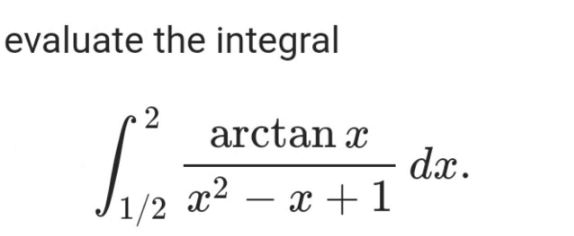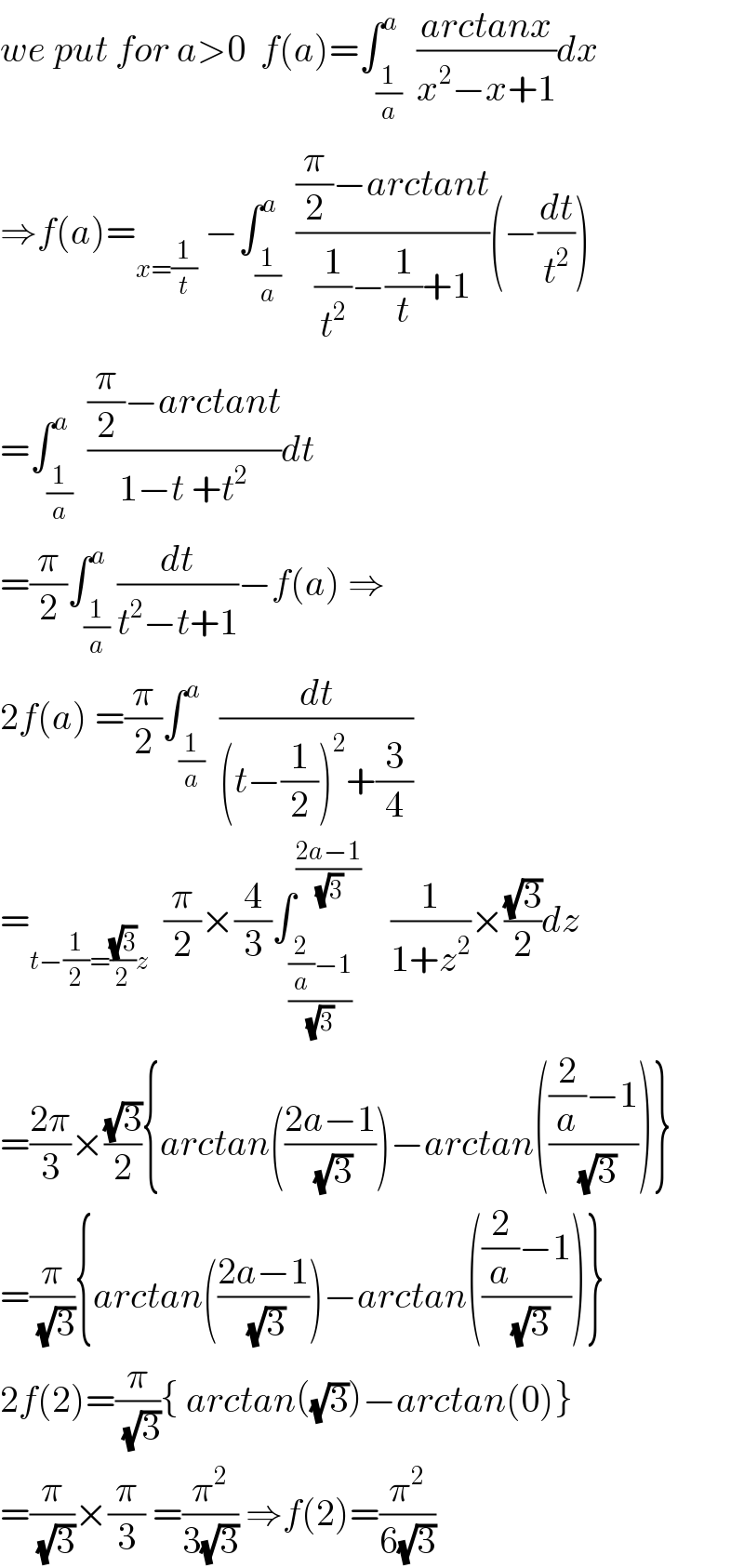Question Number 119006 by A8;15: last updated on 21/Oct/20

Answered by Dwaipayan Shikari last updated on 21/Oct/20
![∫_(1/2) ^2 ((tan^(−1) x)/(x^2 −x+1))dx=I =∫_2 ^(1/2) ((tan^(−1) (1/t))/((1/t^2 )−(1/t)+1)).(dt/(−t^2 )) x=(1/t)⇒1=(1/(−t^2 )).(dt/dx) =∫_(1/2) ^2 (((π/2)−tan^(−1) t)/(t^2 −t+1))dt=I 2I=∫_(1/2) ^2 ((π/2)/(t^2 −t+1))dt 4I=π∫_(1/2) ^2 (1/(t^2 −t+1))dt ((4I)/π)=∫_(1/2) ^2 (1/((t−(1/2))^2 +(((√3)/2))^2 ))dt ((4I)/π)=(2/( (√3)))[tan^(−1) ((2t−1)/( (√3)))]_(1/2) ^2 I=(π/4).(2/( (√3))).(π/3)=(π^2 /( 6(√3)))](https://www.tinkutara.com/question/Q119014.png)
$$\int_{\frac{\mathrm{1}}{\mathrm{2}}} ^{\mathrm{2}} \frac{{tan}^{−\mathrm{1}} {x}}{{x}^{\mathrm{2}} −{x}+\mathrm{1}}{dx}={I} \\ $$$$=\int_{\mathrm{2}} ^{\frac{\mathrm{1}}{\mathrm{2}}} \frac{{tan}^{−\mathrm{1}} \frac{\mathrm{1}}{{t}}}{\frac{\mathrm{1}}{{t}^{\mathrm{2}} }−\frac{\mathrm{1}}{{t}}+\mathrm{1}}.\frac{{dt}}{−{t}^{\mathrm{2}} }\:\:\:\:\:\:\:\:\:\:\:\:\:\:\:\:{x}=\frac{\mathrm{1}}{{t}}\Rightarrow\mathrm{1}=\frac{\mathrm{1}}{−{t}^{\mathrm{2}} }.\frac{{dt}}{{dx}} \\ $$$$=\int_{\frac{\mathrm{1}}{\mathrm{2}}} ^{\mathrm{2}} \frac{\frac{\pi}{\mathrm{2}}−{tan}^{−\mathrm{1}} {t}}{{t}^{\mathrm{2}} −{t}+\mathrm{1}}{dt}={I} \\ $$$$\mathrm{2}{I}=\int_{\frac{\mathrm{1}}{\mathrm{2}}} ^{\mathrm{2}} \frac{\frac{\pi}{\mathrm{2}}}{{t}^{\mathrm{2}} −{t}+\mathrm{1}}{dt} \\ $$$$\mathrm{4}{I}=\pi\int_{\frac{\mathrm{1}}{\mathrm{2}}} ^{\mathrm{2}} \frac{\mathrm{1}}{{t}^{\mathrm{2}} −{t}+\mathrm{1}}{dt} \\ $$$$\frac{\mathrm{4}{I}}{\pi}=\int_{\frac{\mathrm{1}}{\mathrm{2}}} ^{\mathrm{2}} \frac{\mathrm{1}}{\left({t}−\frac{\mathrm{1}}{\mathrm{2}}\right)^{\mathrm{2}} +\left(\frac{\sqrt{\mathrm{3}}}{\mathrm{2}}\right)^{\mathrm{2}} }{dt} \\ $$$$\frac{\mathrm{4}{I}}{\pi}=\frac{\mathrm{2}}{\:\sqrt{\mathrm{3}}}\left[{tan}^{−\mathrm{1}} \frac{\mathrm{2}{t}−\mathrm{1}}{\:\sqrt{\mathrm{3}}}\right]_{\frac{\mathrm{1}}{\mathrm{2}}} ^{\mathrm{2}} \\ $$$${I}=\frac{\pi}{\mathrm{4}}.\frac{\mathrm{2}}{\:\sqrt{\mathrm{3}}}.\frac{\pi}{\mathrm{3}}=\frac{\pi^{\mathrm{2}} }{\:\mathrm{6}\sqrt{\mathrm{3}}} \\ $$$$ \\ $$
Commented by A8;15: last updated on 21/Oct/20
thanks sir
Answered by Bird last updated on 22/Oct/20

$${we}\:{put}\:{for}\:{a}>\mathrm{0}\:\:{f}\left({a}\right)=\int_{\frac{\mathrm{1}}{{a}}} ^{{a}} \:\frac{{arctanx}}{{x}^{\mathrm{2}} −{x}+\mathrm{1}}{dx} \\ $$$$\Rightarrow{f}\left({a}\right)=_{{x}=\frac{\mathrm{1}}{{t}}} \:−\int_{\frac{\mathrm{1}}{{a}}} ^{{a}} \:\frac{\frac{\pi}{\mathrm{2}}−{arctant}}{\frac{\mathrm{1}}{{t}^{\mathrm{2}} }−\frac{\mathrm{1}}{{t}}+\mathrm{1}}\left(−\frac{{dt}}{{t}^{\mathrm{2}} }\right) \\ $$$$=\int_{\frac{\mathrm{1}}{{a}}} ^{{a}} \:\frac{\frac{\pi}{\mathrm{2}}−{arctant}}{\mathrm{1}−{t}\:+{t}^{\mathrm{2}} }{dt} \\ $$$$=\frac{\pi}{\mathrm{2}}\int_{\frac{\mathrm{1}}{{a}}} ^{{a}} \frac{{dt}}{{t}^{\mathrm{2}} −{t}+\mathrm{1}}−{f}\left({a}\right)\:\Rightarrow \\ $$$$\mathrm{2}{f}\left({a}\right)\:=\frac{\pi}{\mathrm{2}}\int_{\frac{\mathrm{1}}{{a}}} ^{{a}} \:\frac{{dt}}{\left({t}−\frac{\mathrm{1}}{\mathrm{2}}\right)^{\mathrm{2}} +\frac{\mathrm{3}}{\mathrm{4}}} \\ $$$$=_{{t}−\frac{\mathrm{1}}{\mathrm{2}}=\frac{\sqrt{\mathrm{3}}}{\mathrm{2}}{z}} \:\:\frac{\pi}{\mathrm{2}}×\frac{\mathrm{4}}{\mathrm{3}}\int_{\frac{\frac{\mathrm{2}}{{a}}−\mathrm{1}}{\:\sqrt{\mathrm{3}}}} ^{\frac{\mathrm{2}{a}−\mathrm{1}}{\:\sqrt{\mathrm{3}}}} \:\:\:\:\frac{\mathrm{1}}{\mathrm{1}+{z}^{\mathrm{2}} }×\frac{\sqrt{\mathrm{3}}}{\mathrm{2}}{dz} \\ $$$$=\frac{\mathrm{2}\pi}{\mathrm{3}}×\frac{\sqrt{\mathrm{3}}}{\mathrm{2}}\left\{{arctan}\left(\frac{\mathrm{2}{a}−\mathrm{1}}{\:\sqrt{\mathrm{3}}}\right)−{arctan}\left(\frac{\frac{\mathrm{2}}{{a}}−\mathrm{1}}{\:\sqrt{\mathrm{3}}}\right)\right\} \\ $$$$=\frac{\pi}{\:\sqrt{\mathrm{3}}}\left\{{arctan}\left(\frac{\mathrm{2}{a}−\mathrm{1}}{\:\sqrt{\mathrm{3}}}\right)−{arctan}\left(\frac{\frac{\mathrm{2}}{{a}}−\mathrm{1}}{\:\sqrt{\mathrm{3}}}\right)\right\} \\ $$$$\mathrm{2}{f}\left(\mathrm{2}\right)=\frac{\pi}{\:\sqrt{\mathrm{3}}}\left\{\:{arctan}\left(\sqrt{\mathrm{3}}\right)−{arctan}\left(\mathrm{0}\right)\right\} \\ $$$$=\frac{\pi}{\:\sqrt{\mathrm{3}}}×\frac{\pi}{\mathrm{3}}\:=\frac{\pi^{\mathrm{2}} }{\mathrm{3}\sqrt{\mathrm{3}}}\:\Rightarrow{f}\left(\mathrm{2}\right)=\frac{\pi^{\mathrm{2}} }{\mathrm{6}\sqrt{\mathrm{3}}} \\ $$
